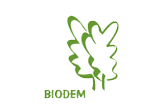Current projects
Dendrom

The BMBF supported cooperative research project DENDROM with total funds of nearly 2 million Euros brings together 17 institutions from scientific and applied fields. The goal is to develop integrated strategies and implementation concepts for the sustainable production of wood for its direct and indirect use as an energy source.The emphasized regions of research are the administrative districts of Uckermark and Barnim in the north and the Elbe-Elster and Oberspreewald-Lausitz districts in the south of the model region Brandenburg.
Head of the project:
Cooperation partners:
Duration:
Financing institutions:
Key words:
Homepage:
Inst. fĂŒr Ăkologische Wirtschaftsforschung, BTU Cottbus, LFE Eberswalde, Leibnitz-Institut fĂŒr Agrartechnik Potsdam-Bornim, Internat. Institut fĂŒr Wald u. Holz MĂŒnster, TFH Wildau, Förderges. Erneuerbare Energien e.V., Kompetenzzentrum HessenRohstoffe Brandenburg, Energie und Technologieinitiative, PIK Potsdam, ZALF, ChorenBiomass GmbH, Volkswagen AG, Landwirtschaftliche Betriebe
06/2005 â 05/2008
BMBF; ProjektrĂ€ger Forschungszentrum JĂŒlich
Energy wood, short rotation, logistic optimization
Biodem
The project BIODEM, financed by PCK-Schwedt, has experimental and demonstrational plots in different regions of Brandenburg to investigate the site potential in regard to the yield of different fast growing trees to be able to compare the yields of wooden and spear-like bio mass considering economical and ecological aspects.
Head of the project:
Cooperation partner:
Duration:
Financing Institution:
Key words:
Homepage:
PCK Schwedt
10/2005 â 05/2009
PCK Schwedt
Energy wood; poplar; willow; BtL-fuels; short rotation
Sustainable management of mixed oak-pine stands in the sub-continental North-East-German lowlands

Cooperative project âOakChainâSub-project âTreatment and Use of Small Diameter Logs of Sessile Oakâ The sub-project works out solutions for processing, product design and marketing of oak wood. The cooperation with the sawmill âHolzindustrie Templin GmbHâ provides the technical facilities for the storage, drying and cutting of the wood. The subsequent treatment takes place both in the sawmill and the technical laboratory of the University of Applied Sciences Eberswalde. Subtask are the investigation of the suitability of small-diameter oak wood for the production of thermally modified oak wood (TMT) and examination of the possibilities to substitute plastics, metals and mineral building materials by semi-finished material, which could be made of small diameter oak wood. The ultimate goal is to implement the results in the future in companies of the forestry-based industry.
Head of the project:
Cooperation partners:
Duration:
Financing institution:
Key words:
BTU, LFE, PIK, TFH, TUD, Holzindustrie Templin
05/2005 â 04/2009
BMBF
Small diameter oak wood
Forest-technical management of the urban forest Treuenbritzen by the UoAS Eberswalde
In close cooperation with the municipality of the city of Treuenbritzen planning and management concepts for the communal forest areas were worked out.
Head of the project:
Duration:
Financing institution:
Key words:
01.01.2002 â open ended
Town of Treuenbrietzen
forest scheduling; operational concept; cultivation model; Controlling
Protected areas in Germany and Climate Change â Risks and management options

In the coming decades protected areas in Germany will be under considerable changes regarding their natural potential due to climate change â independent from uncertainties in the regional pattern of climate change. This problem is a new challenge to national nature protection strategies, including keeping the goals of international conventions. This project strives to make a risk assessment for a comprehensive and representative range of protected areas in Germany. It is to be checked which risks may have an impact on the achievement of certain protection goals. With the ecological risk assessment options for a dynamic nature policy shall be derived in dialogue with stakeholders from public and private nature protection agencies. The primary goal of the presented study is to examine the risks of climate change in regard to nature protection in the 21st century for a comprehensive and representative list of existing protected areas in Germany.
Head of the project:
Cooperation partners:
Duration:
Financing institution:
Key words:
W. Cramer, Potsdam Institut fĂŒr Klimafolgenforschung; S. Klotz, Helmholtzzentrum fĂŒr Umweltforschung Leipzig-Halle; Katrin Böhning-Gaese, UniversitĂ€t Mainz
08 / 2006 - 08 / 2009
Bundesamt fĂŒr Naturschutz
Biodiversity; nature protection; protected areas; climate change
On the transmission of microbial antagonists of Gypsy Moth (Lymantria dispar L.)
The potential of various types of natural antagonists, mainly microsporidia, for the regulation of the population density of the Gypsy Moth (Lymantria dispar) is evaluated. This insect is one of the major forest pests in Germany. Our study is part of an international research project and focuses on the modes of transmission of this group of pathogens. This particular project investigates in which ways and how effectively the microsporidia are transmitted between individuals of the Gypsy moth. Additional to the laboratory experiments, extensive outdoor test are necessary (in cages), as well as research about pathogenity of various isolates (in the laboratory).
Head of the project:
Cooperation partners:
Duration:
Financing institutions:
Key words:
Prof. Dr. A. Linde
Univ. of Illinois; USDA Forest Service; BTU Cottbus
05/2004 â 11/2006
HNE Eberswalde
Biological plant protection; population dynamics; microsporidia
Enlargement of certification and assessment systems in close-to-nature forestry by means of structural biodiversity
In the course of the project indicator structures for natural biodiversity in forest ecosystems are gathered and described. An analysis of the results is being conducted in different temperate forest (USA, Poland). The aim is the enlargement and implementation of assessment systems in national and international controlling systems.
Head of the project:
Cooperation partners:
Duration:
Financing institutions:
Amount of project money:
Key words:
Prof. Dr. A. Linde
Technische UniversitĂ€t MĂŒnchen (Prof. Dr. Fischer)
01. April 2004 â 31. Dezember 2006
Land Brandenburg, Hochschulwissenschaftsprogramm (HWP)
Gesamt: 80.000 Euro
Structural diversity; closeness to nature; forest ecosystems; certification; biodiversity
Heterogenity and formation of patterns in forest soils as and indicator for biodiversity and closeness to nature
The project acts on the assumption that soil patterns develop over many generations of the stand as a product of self-organisation of forest ecosystems. This gives the possibility to interprete variation properties of the soil as a description of the self-organisation potential of an ecosystem. Considering vegetation-, fauna- and stand-data it is to be discussed which processes lead to a specific spatial variation and structure in forest soils, as well as the question which correlation can be detected between soil diversity, on the one hand, and phyto-, zoo- and stand-diversity, on the other. By applying geo-statistic systems spatial variation of soil features is detected to describe the processes of self-organisation in diverse forest ecosystems which lead to the formation of specific soil patterns. Indices for the quantification of soil heterogeneity shall be derived and verified in regard to their compatibility for a diversity assessment of ecosystems (diversity in stand structure, soil fauna, soil vegetation) and the assessment of closeness to nature from a pedogenic point of view.
Head of the project:
Cooperation partners:
Duration:
Financing institutions:
Staff members:
Key words:
Prof. Dr. W. Riek
ZALF MĂŒncheberg, Landesforstanstalt Eberswalde, Parkverwaltung Rezervat Radecin Drawa (Polen)
04/2004 â 04/2006
Deutsche Forschungsgemeinschaft (DFG)
Hr. Dipl.-Biol. F. Hornschuch
Forest soils; soil variability; heterogeneity; biodiversity; closeness to nature
Diversity, taxonomy, biogeography and evolution of the genus Fosterella (Bromeliaceae)
Fosterella species are mesophytic terrestrial herbs distributed across Central South America, with a centre of diversity in arid and semi-humid habitats of Bolivia. Thirteen Fosterella species have been recognized in the most recent monography of the whole bromeliad family by Smith and Downs (1974-1977) in the Flora Neotropica. Numerous new taxa have been discovered since then, raising the actual number of described Fosterella species to 30. Most species are rare and restricted to certain habitats, thus additional species may await their discovery.
Whereas the monophyly of the genus is generally accepted, essentially nothing is known about phylogenetic relationships within the genus. We have initiated a comprehensive systematic analysis of Fosterella, based on traditional as well as molecular characters. Our final aim is a full taxonomic revision of the genus. Molecular data sets comprise genetic fingerprint profiles (e.g., AFLP markers) and chloroplast DNA sequences. Our investigation shall contribute to a better understanding of (1) the systematics and phylogeny of Fosterella and its position within the Bromeliaceae, (2) the biogeography of Fosterella and the long_term dispersal of Bromeliaceae from the Guayana Shield to the Andes, and (3) speciation processes in the Andine valleys of Bolivia.
Head of the project:
Cooperation partners:
Duration:
Financing institutions:
Key words:
Prof. Ibisch
Prof. Weising, Univ. Kassel; Prof. Zizka, Univ. Frankfurt
2005/06
DFG
Fosterella; Bromeliaceae; molecular systematics; phylogeny; AFLP; RAPD; chloroplast DNA, taxonomic revision, international
Ecological attendant investigations in big-scale application of herbicides
Development of decision fundamentals, based on the results of the partial performances of the project, supplemented by own investigations, especially in damage projections.
Head of the project:
Duration:
Financing institutions:
Key words:
Prof. Dr. C. Majunke
09/2005 â 09/2006
Land Sachsen
Monitoring; projection; abatement; forestry pest species
Red deer project
This project does research about the Room-Space-Behaviour of red deer in the north-east-German lowlands by means of satellite telemetry. In this area just few research results are available about how the red deer uses its habitat. To develop measures that contribute to the protection of coherent red deer populations knowledge about the habitat use are of decisive importance.
Head of the project:
Duration:
Financing institutions:
Key words:
Homepage:
Wildlife information system
Development of a specialised wildlife information system to support current research projects of the UoAS Eberswalde in the fields of wildlife biology, wildlife management and hunting skills. The system integrates a dynamic database through an interface into a geographic information system which is specialized in wildlife research. The aim is to optimize the spatial visualisation, processing and analysis of wildlife data and relevant environmental data.
Head of the project:
Duration:
Financing institutions:
Key words:
Homepage:
Prof. Dr. Siegfried Rieger
Wildlife information system; dynamic database; GIS
Application of lead-free hunting ammunition on hoofed game and its influence on hunting practice and socio-dynamics
The project is carried out under the umbrella of the Agricultural and Environmental Ministry of Brandenburg. It investigates the application and impacts of lead-free hunting ammunition by analysis of standardised shooting reports, as well as the opinion of hunters by standardised, anonymous and socio-dynamic questionnaires.
Head of the project:
Duration:
Financing institutions:
Key words:
Homepage:
Development of a system to synchronize registration and analysis of activity data and GPS telemetry data of cloven hoofed animals
The aim of the investigation is the development of a combined systems to register the Room-Space-Behaviour of cloven hoofed animals. Currently animals are located more or less exactly by means of radio and satellite telemetry. Knowledge about the behaviour of the animal at that place and time is difficult to gain. This restricts the use of gained data for concrete management measures extremely. The registration of activity data with collar dispatchers has to be organized in a way which answers the questions what (behaviour) the animal did at which time (time) and where (space) by analysis of the registered activity and GPS data without direct monitoring of the animal.
Head of the project:
Duration:
Financing institutions:
Key words:
Homepage:
Generating a monitoring concept for wildlife damage in the county of Brandenburg
Currently there is no monitoring or inventory system for the registration and assessment of wildlife damage in the forest areas and open landscape of Brandenburg available. Wildlife damage data collected in the course of the State Forest Inventory do not describe the actual situation significantly and are not representative for a regional approach. The aim of the research project is therefore to develop a monitoring concept for the assessment of wildlife damage in forest ecosystems in Brandenburg.
Head of the project:
Duration:
Financing institutions:
Key words:
Homepage:
Diversity, taxonomy, biogeography and evolution of the genus Fosterella (Bromeliaceae)
Fosterella species are mesophytic terrestrial herbs distributed across Central South America, with a centre of diversity in arid and semi-humid habitats of Bolivia. Thirteen Fosterella species have been recognized in the most recent monography of the whole bromeliad family by Smith and Downs (1974-1977) in the Flora Neotropica. Numerous new taxa have been discovered since then, raising the actual number of described Fosterella species to 30. Most species are rare and restricted to certain habitats, thus additional species may await their discovery.
Whereas the monophyly of the genus is generally accepted, essentially nothing is known about phylogenetic relationships within the genus. We have initiated a comprehensive systematic analysis of Fosterella, based on traditional as well as molecular characters. Our final aim is a full taxonomic revision of the genus. Molecular data sets comprise genetic fingerprint profiles (e.g., AFLP markers) and chloroplast DNA sequences. Our investigation shall contribute to a better understanding of (1) the systematics and phylogeny of Fosterella and its position within the Bromeliaceae, (2) the biogeography of Fosterella and the long_term dispersal of Bromeliaceae from the Guayana Shield to the Andes, and (3) speciation processes in the Andine valleys of Bolivia.
Contact
Running time:
External Funding:
Key words:
Homepage:
Prof. Dr. Pierre Ibisch
1 / 2002 -- 5 / 2007
DFG (Deutsche Forschungsgemeinschaft), Bonn http://www.dfg.de
Fosterella; Bromeliaceae; molecular systematics; phylogeny; AFLP; RAPD; chloroplast DNA, taxonomic revision, international












